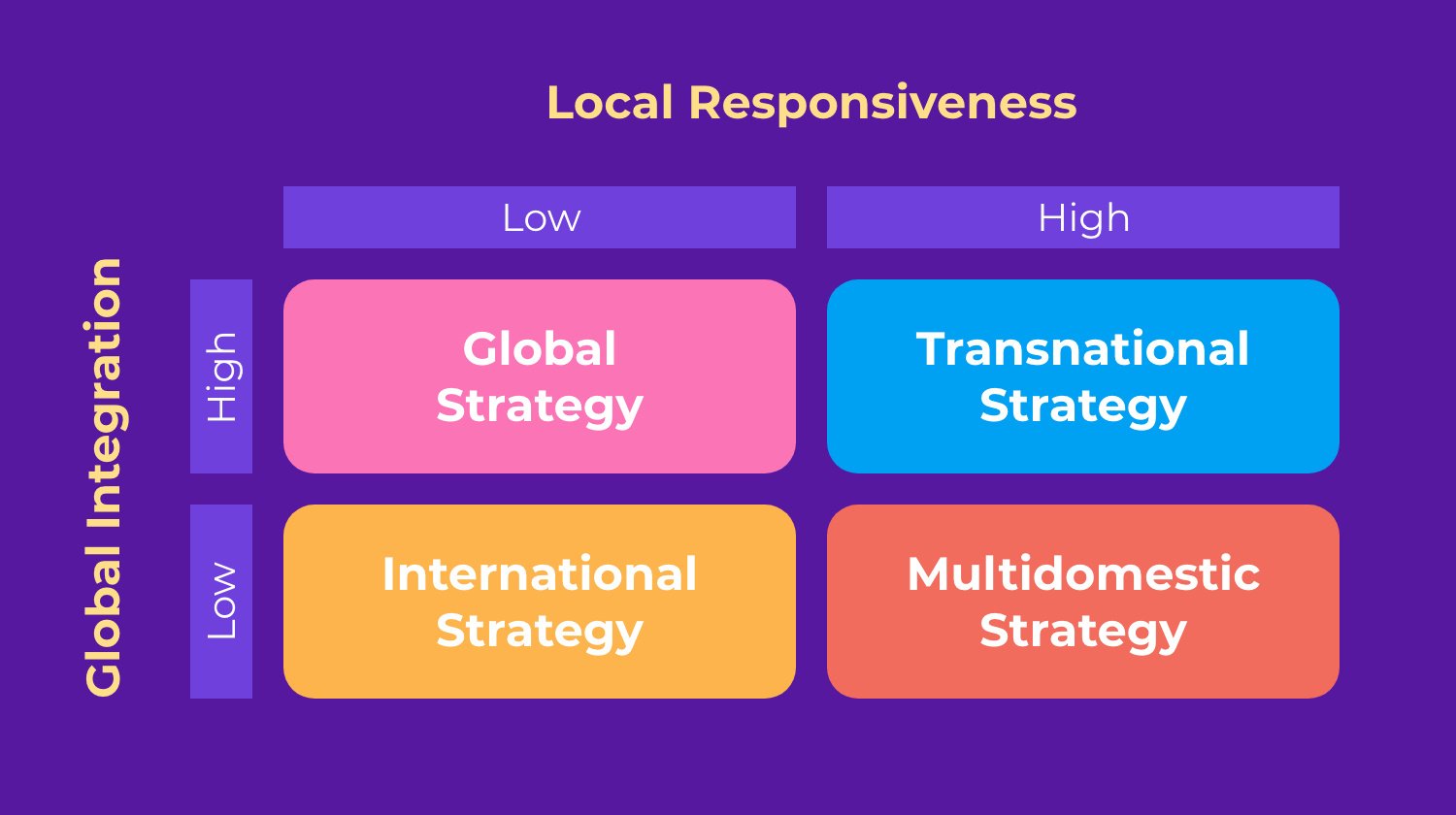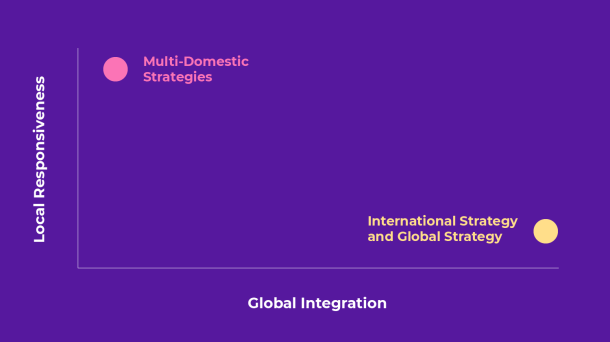So many companies get caught up in expanding their business the “right” way.
But here’s the secret: There is no right way.
In fact, there are four different common strategies businesses use to expand internationally:
Consider each of these strategies on a spectrum between two elements: local responsiveness and global integration.

Local responsiveness refers to how companies serve a specific market’s needs — essentially, how much do they change from market to market? This isn’t just about translating the website or mobile app into a different language, but about the entire customer experience, from payment processes to imagery and product choices or specifications.
Global integration, on the other hand, refers to the standardization companies achieve as they scale. Brands that prioritize global integration have little to no differences between various countries.
It’s up to you how you want to balance these two elements, as determined by your business strategy:
The first strategy: International strategy
A successful international strategy focuses on a single point of operation while exporting products and services around the world. As such, it ranks low on both global integration and local responsiveness.
An international strategy is often the first strategy companies use when they expand to secondary markets, and that’s because it’s the most accessible of the four. It’s essentially an extension of your domestic strategy, operating with a central or head office in your home market and exporting your products to target markets.
The major advantage of this approach is that it’s a quick way to test out the global appeal of your product without making significant investments in infrastructure or staffing in other markets.
Choosing this strategy allows you to:
- Build a standardized, immediately recognizable brand
- Consolidate management processes and lower costs
- Simplify your product portfolio based on what performs well globally
If you’re unsure how your products will respond to different markets or just want to test it out, following the export model is a safe option. However, an international strategy does have its drawbacks, which is why many companies use an international strategy to start with before moving to one of the other three strategies. We’ll explain more below.
With an export-driven strategy, you’re stuck paying higher taxes and tariffs every time you export, and it can be challenging to coordinate supply chains and customer service with only offices in your home market. And just because you’re dipping your toe into a global market, you are not off the hook for translation. Your customers still need to be able to understand what you offer and how to pay for it regardless of the level of global integration you’re pursuing.
Regardless of these challenges, an international strategy is by far the most popular for businesses, especially as they take their first steps toward globalization and international expansion to different countries.
The other most popular type of business that employs this strategy is regional or luxury brands where the location of origin matters. Think about some of the most iconic food and drink in the world — champagne from France or caviar from Russia:
- Moet & Chandon: The iconic champagne has been on the market since 1842 (Napoleon himself was a fan). Now, it remains one of the most popular choices in a $700 million market, boasting a celebrity-packed history from Napoleon to the Oscars. Every bottle is grown, produced, and shipped from 2,000 acres of vineyards across 200 crus in France.
- Red Bull: Austrian company Red Bull started as a small exporting manufacturer in 1987 when their team hit on a brilliant global marketing strategy: giving out free samples to adrenaline junkies in the United States at skateboarding and mountain biking exhibitions. While today’s model is more transnational in nature, the leading energy drink makes more than $2 billion in sales every year.
- Victoria’s Secret: Though the global brand — and ever-present 2000s lingerie chain — has manufacturers from around the world, the company relies primarily on an export model and opening stores in smaller locations like malls and airports as their point of entry with no changes in sizes or styles for women anywhere in the world looking to figure out “the secret.”
The most local responsiveness: Multidomestic strategy
A multi-domestic strategy ranks high on local responsiveness and low on global integration, making it the “local-first” approach of the four strategies. Companies that employ a multi-domestic strategy change their product, messaging, go-to-market, and customer support (among other things) based on each market they enter.
The greatest advantage to this is a highly specialized, localized product that directly matches customer tastes and preferences, with employees on the ground in that market that understand the cultural nuances. Choosing this strategy allows you to:
- Control a portfolio of local subsidiaries that you can scale up and down based on performance
- Easily access local competitive advantages, such as labor, shipping lanes, and natural resources
- Gain a stronger foothold in a local market more quickly
Essentially, multidomestic companies operate with one overarching parent company and a selection of separate companies within each country (sometimes called Greenfield Investments).
This model doesn’t come without challenges, however, as the success of each “domestic” unit requires a deep understanding of that market and resources to spin up completely separate operations in that market. You may have duplicate efforts and siloes across each company, and fundamentally changing your offerings every time you enter a new market can take a lot of up-front time and resources. And with a multi-domestic approach, a strong localization program is the most crucial element (we can help with that!)
Done right, multi-domestic companies can be very successful. In fact, some of the most successful food, wellness, retail, and beverage companies in the world operate this way:
- Johnson & Johnson: Band-Aids, Neutrogena, Splenda, and Tylenol all fall under the Johnson & Johnson umbrella. Operating hundreds of brands in over 60 countries, they’re a household name all over the world.
- Procter & Gamble: Chances are, if a product in your local pharmacy isn’t made by Johnson & Johnson, it’s owned by Procter & Gamble. Billion-dollar brands like Pampers, Downy, Gillette, Always, and Olay are owned by Procter & Gamble. Their portfolio of over 250 brands operates in 140 countries.
- Nestlé: Gerber, Purina, Perrier, Lean Cuisine, Häagen-Dazs, and Toll House are all owned by Swiss-owned candy company Nestlé as part of their portfolio of more than 2000 companies in the food and beverage space. They sell in over 186 countries, each with its selection of brands curated to match local preferences.
The most global integration: Global strategy
On the flip side of the global integration/local responsiveness spectrum is operating with a global strategy. This approach focuses on standardization as much as possible, including colors, messaging, products, and operations, so they can build repeatable, scalable processes no matter which foreign market they operate in. That means having one brand, one suite of products, and one message from a central headquarters.
The advantage of this is that pursuing this strategy gives you an instantly recognizable global brand with a step-by-step path toward global market penetration. Choosing this strategy allows you to:
- Harness economies of scale with efficient processes and operations
- Streamline product development with one product line and minimal changes by market
However, the greatest challenge with global strategy is knowing how much standardization to pursue. Even top global brands still invest in some level of localization and adaptation to local markets — just not so much that it infringes on their scale and efficiency. You should expect to invest in a solid localization process so that your customers can interact with your website, mobile app, packaging, and more in their home language.
Because this model requires a strong global presence to start with, it’s often the end-game for international businesses, moving through the other models before achieving a truly global brand. As a company, you’re taking a gamble that your product has so much universal appeal that it will create demand regardless of market tastes and preferences — which is also why so few companies truly achieve this status:
- Amazon: One of the largest companies in the world, Amazon operates in 58 countries and reaches more than a billion people online every day. The leading e-commerce company in every country except China (where Alibaba is #1), you can see Amazon’s ever-present “smile” on trucks and packages — and enjoy same-day shipping — pretty much everywhere.
- Apple: Since releasing the original Mac in 1984, Apple rose to dominance for its sleek lines, clean interface, and easy-to-use software. Globally, Apple’s technology is the same (with a few minor changes) wherever you go. Considered one of the biggest global brands today, Apple operates in over 175 countries around the world with more than 100,000 employees.
- Disney: It’s a small world, after all. Whether you’re visiting parks in Shanghai or California, you’ll be able to experience the same magic. For movies, merchandise, and TV shows, Disney’s team works to make sure it’s as globally inclusive as possible with only minor changes if needed based on audience feedback (say, for the title of a film.)
The best of both: Transnational strategy
While a global strategy may seem like the end-game, for many brands, the best choice is a transnational strategy, which splits the difference in terms of local responsiveness and global integration.
Transnational businesses operate with a central or head office in one country (the global integration part) and also employ local subsidiaries in international markets (the local responsiveness part). That way, they get the best of both worlds: one overarching brand that provides a cohesive structure and efficient center of operations while optimizing for local market preferences and tastes as needed. Choosing this strategy allows you to:
- Create a standardized brand that’s immediately recognizable but accommodate differences in market preferences
- Centralize and streamline operations, getting the advantage from economies of scale
- Be able to flex between a high-level strategic overview of investments without losing customer-centricity with local markets
Of the four models, transnational has the most variation. Some businesses give more autonomy to their local branches than others. Balancing corporate decisions vs. local decisions remains one of the biggest challenges for global companies, which cascades across all aspects of the business, from staffing to marketing decisions. Some choose to localize on an in-depth level, changing products and operations (like a multidomestic model), while others standardize more rather than less (like a globalization model).
Keeping local customers in mind, rather than just selling to foreign markets, is what makes transnational strategies so successful, like these companies:
- McDonald’s has a global scale with 36,000 fast food locations in more than 100 different countries worldwide. They adapt their menu and prices based on the market, from a McSpicy Paneer in India (fried paneer cheese, tandoori sauce, and lettuce) or poutine (french fries with gravy) in Canada.
- Nike sneakers and sports apparel can be found in over 170 countries, but they change their network of influential sports celebrities and marketing strategy based on the market. Depending on what sports matter, you can hear from soccer phenom Cristiano Ronaldo to basketball star LeBron James and tennis champion Rafael Nadal.
- Coca-Cola’s localization approach means you can order a “Coke,” a “Cola,” or a “Coca” (which have a slightly different formula) depending on the market. What makes this work across their 200+ countries is universal marketing messages of happiness, enjoyment, and sharing. Combining this standardization with variations in local flavors and packaging makes them successful.
Think local, act global with Smartling
Even companies operating with models that favor global standardization over local responsiveness have to invest in localization and translation to be successful. That’s because regardless of the level of local responsiveness, your customers in foreign markets expect to interact with you in their language. In fact, when deciding where to buy, 56% of e-commerce customers say having a website in their language is more vital than price.
Smartling offers a world-class translation software solution built for you however you plan to scale your business. No matter how many markets you choose to enter or local subsidiaries you build and acquire, you can professionally translate and localize all of your content across devices and platforms without sending a single email, touching any button, or managing strings in spreadsheets.
Want to learn how you can deliver one unique brand voice to every global market? Get started with Smartling's easy-to-use localization style guide template.

.jpg)
%20How%20to%20create%20a%20localization%20style%20guide%20Template%20and%20tips%20(600%20x%20200%20px).png?width=600&height=200&name=(600x200)%20How%20to%20create%20a%20localization%20style%20guide%20Template%20and%20tips%20(600%20x%20200%20px).png)





